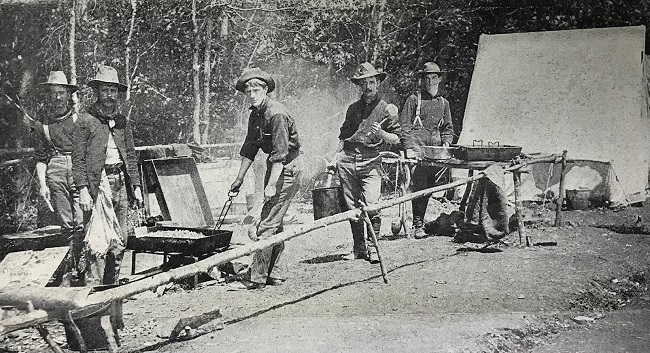
Setting Up an Army Field Kitchen

Typical U.S. Army Kitchen
Please Visit our Home
Page to learn more about the Spanish American War
General:
Unlike the Navy, the U.S. Army had developed an official cookbook for the
use of army cooks. In addition to recipes, the cookbook had a lot of other
advice. Below is a section describing how to set up a basic field kitchen.
The article:
COOKING PLACES.
Each compâny should have its own kitchen on flank of, and in line with,
its row of tents. The simplest kitchen consists of a trench dug in the
direction parallel with the wind, of such width that the kettle, when
placed on it, does not project beyond it more than an inch on each side;
its depth should be 12 inches at the end from which the wind is blowing,
and continue this depth for 4 feet, decreasing then gradually to 3 inches
at the opposite end, where a space must be left equal to the breadth of
the trench, to serve as a chimney. The fire is lit at the end where the
trench is deep; it should not extend beyond 3 or 4 feet up the trench. The
kettles are placed touching one another; dry sods should be used to stop
up the chinks made by the roundness of the kettles, so that the space
under them may form a flue. It is advisable to pile up sod, or, with
stones and carth, to erect a chimney of at least one foot in height at the
end farthest from the fire. All grass around the fireplaces should be cut
to prevent accidents from fire.
If the command halts for more than one day, these kitchens are susceptible
of great improvement; the chimney can be made of mud, or twigs and mud,
and the draft may be increased by using short pieces of hoop iron as bars,
stretched across the trench to support a filling in of clay around each
kettle; or, in other words, to make a regular place for each kettle into
which it will fit exactly, so that its position may be changed. As the day
following the wind may change to an exactly opposite direction, a similar
trench must be dug in continuation of the former one, the same chimney
being used. In this manner one chimney will serve for trenches cut to suit
the wind blowing from all four quarters. The openings from these trenches
into the chimney must all be closed with sod, except the one in use. In
some places, where bricks or stones suitable to the purpose are to be had,
it is better to construct these kitchens on the ground instead of below
the surface.
In well-wooded countries, two logs side by side and parallel to the
direction of the wind, the fire being kindled between them, make a good
kitchen. In such places fuel is no object, so the construction of chimneys
can be dispensed with, and the kettles hung from a stick resting at each
end on a forked upright.
HOW TO MAKE A COOKING FIRE FOR A SMALL CAMP.
Lay down two green poles (5 by 6 inches thick, and 2 feet long) 2 or
3 feet apart, with notches in the upper side about 10 to 12 inches apart.
Let the ground be leveled meantime.
Take two more green poles (6 by 8 inches thick, and 4 feet long) and lay
them in the notches. Procure a good supply of dry wood, bark, brush, or
chips, and start your fire on the ground between the poles. The air will
circulate under and through your fire, and the poles are just the right
distance apart to set your camp kettle, frying pan, or coffee pot on.
If you re going to cook several days in this place, it will
pay you to jut up a crane, This is built as follows: Cut two green posts
(2 inches thick and 3 feet long), which drive into the ground a foot from
either end of yóur fire, and then split the top end of each with the ax
(unless they be forked). Then cut another green pole, of same size, and
long enough to reach from one of these posts to tho other; flatten the
ends and insert them in the splits. The posts should be of such
height that when this pole is passed through the bail of the camp kettle,
the latter will swing just clear of the fire. Other cooking utensils may
be used as required.
DISPOSAL OF REFUSE
Particular attention is directed to the cleanly method of burning
all kitchen refuse in the camp fire; it will not affect the cooking. Burn
everything - coffee grounds, parings, bones, meats, even old tin cans, for
if thrown out anywhere, even buried, they attract flies. Tin cans are
flytraps - burned and cleaned out of fire daily they are harmless. Fires
should be cleaned of burnt refuse once a day, as refuse burned will not
attract flies; Cleanliness is a good doctor. The burning of refuse,
not burying it, is a splendid rule, especially in a large command or
permanent camp."
Bibliography:
Manual for Army Cooks.
(Washington; Government Printing Office, 1896) 209-211.
Farm and Fireside. Vol.
XXII, No. 4, November 15,1898 (photo of Army kitchen).
Support this
Site by Visiting the Website Store! (help
us defray costs!)
We are providing
the following service for our readers. If you are interested in
books, videos, CD's etc. related to the Spanish American War, simply
type in "Spanish American War" (or whatever you are interested
in) as the keyword and click on "go" to get a list of titles
available through Amazon.com.
Visit Main Page
for copyright data


